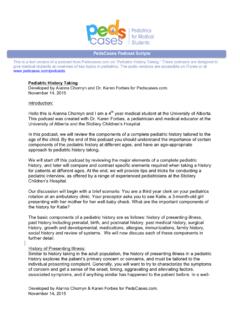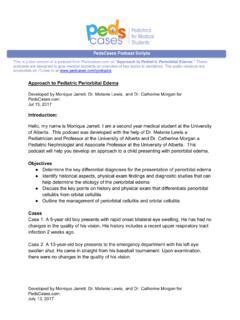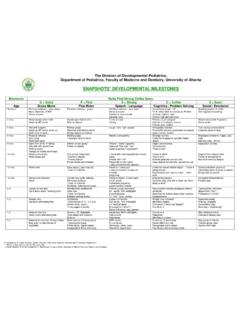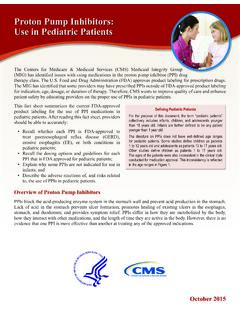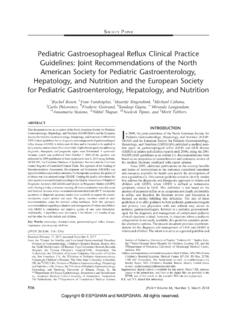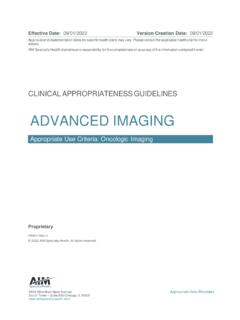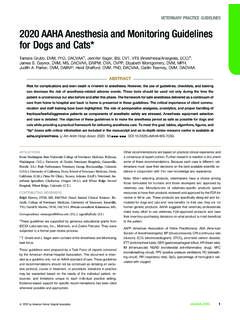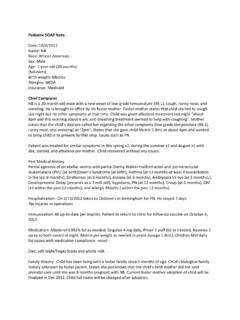Transcription of PedsCases Podcast Scripts
1 Developed by Erin Boschee and Dr. Melanie Lewis for August 25, 2014 Developed by Erin Boschee and Dr. Melanie Lewis for August 25, 2014. Approach to pediatric Vomiting (Part 1) Introduction Hi, Everyone! My name is Erin Boschee and I m a medical student at the University of Alberta. This Podcast was reviewed by Dr. Melanie Lewis, a General Pediatrician and Associate Professor at the University of Alberta and Stollery Children s Hospital in Edmonton, Alberta, Canada. This is the first in a series of two podcasts discussing an approach to pediatric vomiting. We will focus on the following learning objectives: 1) Create a differential diagnosis for pediatric vomiting. 2) Highlight the key causes of vomiting specific to the newborn and pediatric population. 3) Develop a clinical approach to pediatric vomiting through history taking, physical exam and investigations.
2 Case Example Let s start with a case example that we will revisit at the end of the podcasts. You are called to assess a 3-week old male infant for recurrent vomiting and feeding difficulties. The ER physician tells you that the mother brought the baby in stating that he started vomiting with every feed since around two weeks of age. In the last three days he has become progressively more sleepy and lethargic. She brought him in this afternoon because he vomited so forcefully that it sprayed her in the face. The physician confirms that the baby is stable, and his vitals are within normal range, except that he is mildly tachycardic. What else will you want to ask when you go to see the baby? What will you look for on physical exam and what tests might you order? PedsCases Podcast Scripts This is a text version of a Podcast from on Approach to pediatric Vomiting.
3 These podcasts are designed to give medical students an overview of key topics in pediatrics. The audio versions are accessible on iTunes or at Developed by Erin Boschee and Dr. Melanie Lewis for August 25, 2014 Before we think about our clinical approach to this vomiting infant, let s take a few minutes to discuss some of the common causes of pediatric vomiting. Pathophysiology Vomiting is the forceful expulsion of the stomach contents through the mouth via contraction of the abdominal and chest wall muscles. An emetic response may be triggered by irritation of the gastric mucosa by toxins, drugs or overdistension, which stimulates vagal afferents to the vomiting center in the brain. Afferent impulses from other areas of the brain, such as the vestibular system, the amygdala (as with emotion or fear), or from certain organs outside the GI tract can stimulate vomiting in a similar mechanism.
4 Stimulation of the chemoreceptor trigger zone in the area postrema of the 4th ventricle by toxins, electrolyte or metabolic disturbances or increased intracranial pressure also results in vomiting through activation of the vomiting center. It can be helpful to think of the pathophysiological mechanisms that cause vomiting when trying to create a differential diagnosis. Differential Diagnosis Vomiting is a very common pediatric presentation, and the differential is extremely broad. While GI (gastrointestinal) causes tend to come to mind first, there are many non-GI causes for vomiting that have to be considered. The causes for pediatric vomiting can be broken into categories including gastrointestinal, infectious, neurologic, metabolic/endocrine, respiratory, toxin or medication-related and psychogenic or behavioral. Now that you know a broad systems approach to the causes of vomiting, let s focus a bit more on some of the common specific conditions.
5 Gastrointestinal Causes There are several approaches that can be followed when considering the GI causes of pediatric vomiting. A simple approach is to group the causes by age as different diagnoses tend explain vomiting in newborns versus vomiting in infants and older children. Important causes of vomiting in the newborn period include pyloric stenosis, duodenal atresia, intestinal malrotation and tracheo-esophageal fistula. We ll spend a few minutes now discussing the distinguishing features of these conditions. Pyloric stenosis is the hypertrophy of the pyloric muscles at the outlet of the stomach. This results in projectile, non-bilious vomiting immediately following feeds that presents in the first few weeks of life. Infants are classically firstborn males with a positive family history of pyloric stenosis, and may have visible abdominal peristalsis or a palpable olive-shaped mass near the umbilicus.
6 It is considered a medical (not surgical) Developed by Erin Boschee and Dr. Melanie Lewis for August 25, 2014 emergency due to the risk of severe electrolyte disturbances classically, a hypochloremic hypokalemic metabolic alkalosis. Duodenal atresia is the congenital absence of a portion of the first part of the small bowel. Symptoms typically present shortly after birth. They may present with either bilious or non-bilious vomiting, depending whether the atresia is distal or proximal to the ampulla of Vater, the site where bile and pancreatic enzymes are released into the duodenum from the common bile duct. It typically does not present with abdominal distension. A classical x-ray finding associated with duodenal atresia is the double bubble sign. In contrast, intestinal malrotation, a congenital anomaly in rotation of the midgut as it forms, presents as intermittent bilious vomiting, usually with significant abdominal distension.
7 It may be associated with severe abdominal pain if associated with midgut volvulus causing bowel ischemia. Since the bowel obstruction is often intermittent, the timing of presentation can be variable. Bilious or bile-stained vomiting should be treated as a potential surgical emergency. Tracheo-esophageal fistula, or TEF, is an abnormal connection between the trachea and esophagus. TEF usually presents with cough, cyanotic episodes with feeding, respiratory distress, or recurrent pneumonia. Other defects associated with the VACTERL association may be present, such as vertebral anomalies, anal atresia, congenital heart disease, renal or radial anomalies or limb defects. There are five different forms of TEF, which are distinguished by the location of the esophageal atresia and connection to the trachea. Types with a complete esophageal atresia typically present shortly after feeding begins as there is a complete obstruction.
8 However, other variants such as the H-type of TEF may present later in life with symptoms of recurrent cough or aspiration pneumonia. This is because the main feature is an abnormal connection to the trachea, and there is no complete esophageal atresia. Necrotizing enterocolitis is common in premature infants and may present as decreased feeding tolerance, vomiting, abdominal distension, diarrhea or hematochezia. Other neonatal causes of vomiting include meconium ileus, Hirschsprung disease, and imperforate anus. After the newborn period, important gastrointestinal causes of vomiting include gastroesophageal reflux disease (GERD), intussusception and other causes of bowel obstruction, food allergy, eosinophilic esophagitis and appendicitis. Gastro-esophageal reflux (GER) is extremely common and typically presents in infants between 1-3 months of age. It is characterized by frequent small volume regurgitation of a milky substance, irritability with feeds or when lying supine, or back arching with feeds.
9 Many infants are asymptomatic. Gastro-esophageal reflux is a normal physiologic process in infants and must be distinguished from gastro- Developed by Erin Boschee and Dr. Melanie Lewis for August 25, 2014 esophageal reflux disease (GERD), which is associated with esophagitis, failure to thrive and recurrent aspiration. Intussusception involves invagination of a portion of the small bowel into another portion of bowel. It is the most common cause of intestinal obstruction in children six to 36 months of age. In addition to vomiting, the classic triad of features includes intermittent, progressive abdominal pain, red currant jelly stools and a palpable sausage-like abdominal mass. Food allergies such as milk protein allergy in infants or celiac disease in older infants and children are other fairly common causes of vomiting. Eosinophilic esophagitis, a disease characterized by eosinophilic infiltrates in the esophagus is another cause of vomiting often found in older children or adolescents with a history of asthma, atopy and eczema, who complain of food sticking in the esophagus.
10 Lastly, appendicitis is a common GI cause of vomiting in children and adolescents that should not be missed. Usually, there will also be a history of fever and abdominal pain. Non-Gastrointestinal Causes Let s take a few moments to review the common non-GI causes of vomiting in children. The classic infectious cause of vomiting is gastroenteritis, and it is likely the most common cause of vomiting from infancy into adolescence. It is typically associated with fever, diarrhea and/or abdominal cramping or pain. Often there is a history of sick contacts. Gastroenteritis can become quite serious, especially in infants and younger children, who are highly susceptible to dehydration and electrolyte disturbances. Other common infectious causes in children must also be considered. These can include urinary tract infections, meningitis and sepsis. Note that meningitis and pyelonephritis classically present with vomiting and fever.
